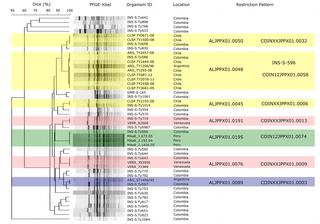当前位置:
X-MOL 学术
›
PLOS Negl. Trop. Dis.
›
论文详情
Our official English website, www.x-mol.net, welcomes your
feedback! (Note: you will need to create a separate account there.)
Surveillance of Salmonella enterica serovar Typhi in Colombia, 2012-2015.
PLOS Neglected Tropical Diseases ( IF 3.4 ) Pub Date : 2020-03-10 , DOI: 10.1371/journal.pntd.0008040 Paula Diaz-Guevara 1 , Lucy Angeline Montaño 1 , Carolina Duarte 1 , Gabriela Zabaleta 1 , Mailis Maes 2 , Julio Cesar Martinez Angarita 3 , Duy Pham Thanh 4 , William León-Quevedo 5 , Carlos Castañeda-Orjuela 5 , Claudia Jimena Alvarez Alvarez 3 , Jaime Guerrero 3 , Miriam Moroni 6 , Josefina Campos 6 , Enrique Pérez 7 , Stephen Baker 2
PLOS Neglected Tropical Diseases ( IF 3.4 ) Pub Date : 2020-03-10 , DOI: 10.1371/journal.pntd.0008040 Paula Diaz-Guevara 1 , Lucy Angeline Montaño 1 , Carolina Duarte 1 , Gabriela Zabaleta 1 , Mailis Maes 2 , Julio Cesar Martinez Angarita 3 , Duy Pham Thanh 4 , William León-Quevedo 5 , Carlos Castañeda-Orjuela 5 , Claudia Jimena Alvarez Alvarez 3 , Jaime Guerrero 3 , Miriam Moroni 6 , Josefina Campos 6 , Enrique Pérez 7 , Stephen Baker 2
Affiliation

|
Salmonella Typhi (S. Typhi) is the causative agent of typhoid fever; a systemic disease affecting ~20 million people per year globally. There are little data regarding the contemporary epidemiology of typhoid in Latin America. Consequently, we aimed to describe some recent epidemiological aspects of typhoid in Colombia using cases reported to the National Public Health Surveillance System (Sivigila) between 2012 and 2015. Over the four-year reporting period there were 836 culture confirmed cases of typhoid in Colombia, with the majority (676/836; 80.1%) of reported cases originated from only seven departments. We further characterized 402 S. Typhi isolates with available corresponding data recovered from various departments of Colombia through antimicrobial susceptibility testing and molecular subtyping. The majority (235/402; 58.5%) of these typhoid cases occurred in males and were most commonly reported in those aged between 10 and 29 years (218/402; 54.2%); there were three (0.74%) reported fatalities. The overwhelming preponderance (339/402; 84.3%) of S. Typhi were susceptible to all tested antimicrobials. The most common antimicrobial to which the organisms exhibited non-susceptibility was ampicillin (30/402;7.5%), followed by nalidixic acid (23/402, 5.7%). Molecular subtyping identified substantial genetic diversity, which was well distributed across the country. Despite the diffuse pattern of S. Typhi genotypes, we identified various geographical hotspots of disease associated with local dominant genotypes. Notably, we found limited overlap of Colombian genotypes with organisms reported in other Latin American countries. Our work highlights a substantial burden of typhoid in Colombia, characterized by sustained transmission in some regions and limited epidemics in other departments. The disease is widely distributed across the country and associated with multiple antimicrobial susceptible genotypes that appear to be restricted to Colombia. This study provides a current perspective for typhoid in Latin America and highlights the importance of pathogen-specific surveillance to add insight into the limited epidemiology of typhoid in this region.
中文翻译:

2012-2015年哥伦比亚沙门氏菌血清型伤寒监测。
伤寒沙门氏菌(S. Typhi)是伤寒的病原体。全球每年影响约2000万人的系统性疾病。关于拉丁美洲伤寒的当代流行病学的资料很少。因此,我们旨在使用2012年至2015年间向国家公共卫生监视系统(Sivigila)报告的病例来描述哥伦比亚最近发生的伤寒流行病学方面。在四年的报告期内,哥伦比亚有836例经文化证实的伤寒病例,大部分(676/836; 80.1%)的报告病例仅来自七个部门。我们进一步对402伤寒沙门氏菌进行了鉴定,并通过抗菌药敏试验和分子亚型分析从哥伦比亚各个部门获得了可用的相应数据。多数(235/402; 58。这些伤寒病例中有5%发生在男性中,最常见的是年龄在10到29岁之间的人群(218/402; 54.2%);报告的死亡人数为三(0.74%)。伤寒沙门氏菌占绝大多数(339/402; 84.3%)易受所有测试的抗生素的影响。生物体最不敏感的是氨苄西林(30/402; 7.5%),其次是萘啶酸(23/402,5.7%)。分子分型确定了大量遗传多样性,在全国范围内分布良好。尽管有伤寒沙门氏菌基因型的扩散模式,我们还是发现了与当地优势基因型有关的各种疾病热点。值得注意的是,我们发现哥伦比亚基因型与其他拉丁美洲国家/地区报道的生物重叠有限。我们的工作突显了哥伦比亚的伤寒负担,其特点是在某些地区持续传播,而在其他部门流行有限。该病在全国各地广泛分布,并与似乎仅限于哥伦比亚的多种抗微生物基因型有关。这项研究提供了拉丁美洲伤寒的最新观点,并强调了病原体特异性监测的重要性,以增加对该地区伤寒流行病学的认识。
更新日期:2020-03-10
中文翻译:

2012-2015年哥伦比亚沙门氏菌血清型伤寒监测。
伤寒沙门氏菌(S. Typhi)是伤寒的病原体。全球每年影响约2000万人的系统性疾病。关于拉丁美洲伤寒的当代流行病学的资料很少。因此,我们旨在使用2012年至2015年间向国家公共卫生监视系统(Sivigila)报告的病例来描述哥伦比亚最近发生的伤寒流行病学方面。在四年的报告期内,哥伦比亚有836例经文化证实的伤寒病例,大部分(676/836; 80.1%)的报告病例仅来自七个部门。我们进一步对402伤寒沙门氏菌进行了鉴定,并通过抗菌药敏试验和分子亚型分析从哥伦比亚各个部门获得了可用的相应数据。多数(235/402; 58。这些伤寒病例中有5%发生在男性中,最常见的是年龄在10到29岁之间的人群(218/402; 54.2%);报告的死亡人数为三(0.74%)。伤寒沙门氏菌占绝大多数(339/402; 84.3%)易受所有测试的抗生素的影响。生物体最不敏感的是氨苄西林(30/402; 7.5%),其次是萘啶酸(23/402,5.7%)。分子分型确定了大量遗传多样性,在全国范围内分布良好。尽管有伤寒沙门氏菌基因型的扩散模式,我们还是发现了与当地优势基因型有关的各种疾病热点。值得注意的是,我们发现哥伦比亚基因型与其他拉丁美洲国家/地区报道的生物重叠有限。我们的工作突显了哥伦比亚的伤寒负担,其特点是在某些地区持续传播,而在其他部门流行有限。该病在全国各地广泛分布,并与似乎仅限于哥伦比亚的多种抗微生物基因型有关。这项研究提供了拉丁美洲伤寒的最新观点,并强调了病原体特异性监测的重要性,以增加对该地区伤寒流行病学的认识。











































 京公网安备 11010802027423号
京公网安备 11010802027423号